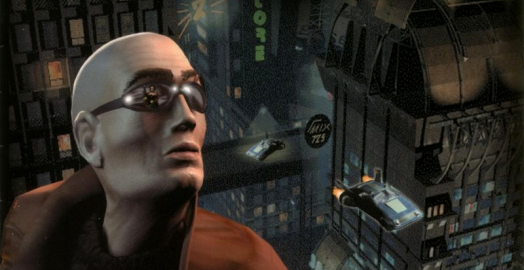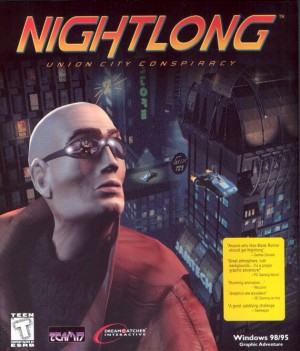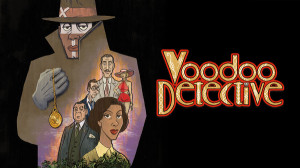Nightlong: Union City Conspiracy flashback review

Our original September 2002 review for Nightlong: Union City Conspiracy summarises, “This is a fun, puzzle-intensive, good-looking game that satisfies in almost every respect.” Nearly 22 years later, this game can be purchased from the usual outlets or even as an original boxed game for reasonable money. Is it worth the outlay today?
Released just a few years before our first review, in 1998, Nightlong: Union City Conspiracy was developed by Italian software house, Trecision, who became the largest developer in Italy before going bankrupt due to financial failures of upcoming projects. It seems that Nightlong was set to be the sequel to one of their earlier adventure games, titled Alien Virus, but was modified to become a cyberpunk thriller instead.
The story was then and is now, a well-trodden path of science-fictional cliches. There are the flying cars, the mega-corporations, cyber criminals, the cryo-somethingorother. It’s all here, by the numbers in fact, as concisely outlined in the game’s nicely filmic introductory sequence.
You play as Joshua Reev (with no ‘e’ at the end — I think this must be the Italian spelling), an ex-military undercover type of guy. Your mission is to infiltrate a mysterious cyber-terrorist organisation that has been attacking the Genesis Cryogenetic Enterprise. This is some sort of mega-corporation with strong political connections back to your friend Hugh Martens, the mayor of Union City. He explains everything as you speed through the megalopolis at night in his flying Lotus Esprit-like automobile — science fiction by the numbers like I said.
Joshua initially put me in mind of JC Denton from classic science fiction RPG-shooter Deus Ex. It was a common look for undercover tough guys from the late 20th Century: sunglasses practically bonded to the low-poly face, a leather jacket and not a flicker of a smile. The comparison soon dissolves, though, as JC Denton is very much the strong silent type, whereas Joshua turns out to be positively chatty in comparison. At many points throughout the game, especially in the cut scenes, he can almost barely contain himself as he spills copious amounts of information about the plot, your progress and the other game characters.
He is voiced by Hollywood actor Jay Benedict, who sadly died in 2020. Benedict (who also played Newt’s father in the film Aliens, in a scene that was entirely cut from the final cinema release) plays Joshua with a voice pitched somewhere between James Woods and Smithers from The Simpsons. I have read numerous complaints about the game’s voice acting, but I quite enjoyed Benedict’s performance. It is a little monotonous and dry but suits Joshua’s objective-focused character, and it’s quite humorous at times. Other characters range from good to adequate, to absolutely awful (especially the “French” bartender you meet in the city.)
Getting back to the story, you learn that your first task is to find out what has happened to the previous undercover operative, Agent Ruby, who had been working for Martens. He has been missing for 24 hours and the mayor fears the worst. Now they want you to take over, posing as a criminal known to the police, and who may be on the side of the terrorists. To begin, you must gain access to Ruby’s flat to look for clues to his whereabouts.
The main thrust of the story in Nightlong involves Joshua attempting to enter places he shouldn’t be exploring. Getting into Ruby’s flat is fairly straightforward, if clumsily handled by Joshua, who proves himself to be far from an expert in these matters. From there, you have to gain entry to the subway, which is in lockdown because of the terrorists, then to a cellar where you can find items to help you get into a local bar, a disused museum, and so on.
The solutions to these puzzles are often hopelessly illogical. In one location you have to attach a dead rat to a roller skate to scare away a lady in your way. In another, you spend ages looking for the correct electric socket adapter so you can plug in a hologram generator to distract a thug. In yet another, you’re in search of a replacement lightbulb! It's nearly always a slightly bonkers solution to a fairly undemanding situation.
The problem with this is that although they are quite good fun, they’re not the kind of puzzles you expect to constantly face in a science fiction adventure set in a conspiratorial and Blade Runner-esque world. There are moments of secret code-breaking and jerry-rigging electronics, but as a whole, it’s not exactly the height of science-fictional drama.
What this adds up to is a game that’s playable but, like its story, too generic and even a little dull at times. If it had been more of a comedy game, some of these solutions would have been funny and could have easily been pushed further into the realms of the ridiculous, but that’s not what the developers were aiming for here. It’s a slow and rather serious story, even if some characters are occasionally light-hearted in their presentation. There is a sense of the mundane about it all.
There can be quite a bit of “pixel peeping” to find certain objects too (like the aforementioned socket adapter — hint: it’s in the storage area that needs that new bulb) which increased my frustration levels at times. Add to this a lot of backtracking and re-exploring of already-combed areas, not to mention long and verbose cut scenes which can leave you a bit confused.
Despite these issues, the puzzles are still well constructed for the most part, with clear and somewhat satisfying progression in the longer challenges which span many locations. They are seldom too taxing and although I have read several complaints about the puzzles being too easy, I found the balance of difficulty about right, except where the solution wanders too far into the illogical — but which 90s adventure doesn’t do that on occasion?
Where Nightlong really manages to shine, distancing itself from many of its contemporaries, is in its graphics which are simply beautiful at times. Every location is carefully designed, drawn and pre-rendered, with strong use of colour and shadow. The mood varies from futuristic city scenes to wild jungle locations with strange statues and robotic animals. Each new location, of which there are many, is a delight to behold.
The character animation is smooth and convincing, especially when Joshua has to perform some sort of action sequence on completing a puzzle. He moves nicely around the screen at just about the right pace, and it’s also possible to pass quickly through rooms by clicking on an exit with the right mouse button. The control system is slick and still feels good today, with responsive environments and an unobtrusive point-and-click system.
In contrast, the many cut scenes you must sit through are heavy-handed and overly long, with comparatively poor use of colour and animation, and unpleasant looking magnification of the 3D textures. There’s also some of the worst lip-synching seen in an era not noted for its great lip-synching. It’s a shame these scenes can’t be skipped.
As the game proceeds, Joshua has to enter a virtual world to complete an extended episode on the trail of the missing scientist, Dr. Moreau (no, not that one, another Dr. Moreau!). The use of VR was felt to be interesting and edgy in the late 90s but this was the least successful part of the game for me. I didn’t enjoy the strange fantasy scenario that the game drops the player into — it’s a sort of gothic fairground with mazes and werewolves, and contrasts too much with what has come before. It’s easy to forget this is supposed to be a futuristic thriller and not a medieval fantasy. Even though it’s VR, it’s presented in exactly the same third-person style as the rest of the game, so it’s all a bit confusing, really. I almost stopped playing here to be honest but persevered using a walkthrough to get through some parts more quickly.
After this protracted sequence, Joshua finds himself back in “reality”, this time flying to an island just off the coast of Mexico to rescue some missing people and complete his exposé of the conspiracy. It’s a more cooperative affair, with Joshua joined by several comrades who are needed in some fairly tough puzzle-solving sequences. The ending feels like a Cold War prison escape movie and is a world away from the cyberpunk stylings of the first part of the game, and the fantasy environment of the VR world. The different parts of Nightlong don’t really gel at all, which is another of the game’s obvious weaknesses.
When I began playing Nightlong, I was surprised I hadn’t heard of it before. It looked amazing, and it sounded pretty good too — voices notwithstanding, the music and sound effects throughout are quite atmospheric, although you probably wouldn’t want the CD soundtrack. The story also initially seemed to be something I would have enjoyed, especially as science fiction was not such a common setting for adventure games when it was released. However, it does become clear after an hour of gameplay why this one has been left behind in the previous century. The game’s weaknesses make themselves too strongly felt: the mundane puzzle solutions, the ‘seen-it-all-before’ plot and characters, the definite lack of sparkle to the proceedings as a whole.
I can’t wholeheartedly recommend Nightlong: Union City Conspiracy in 2024 if you are looking for your next adventure game. However, I did quite enjoy it — especially the first half — and if you can get it on special offer or find a reasonably priced original copy, it could be one for your collection. If you are particularly keen to play a science fiction adventure with 1990s charm, LucasArt’s 1995 The Dig, for example, is different but quite a bit better. More recently, something like Norco looks like a far more sophisticated challenge. Nightlong, as the name suggests, represents a prolonged and, at times, wearisome night of game playing for the most part, with more inconsistencies and cliches than is healthy. Equally though, it does provide a smooth experience, with graphics that still impress and plenty of nice puzzles that won’t hurt your brain too much.



_capsule_fog__medium.png)

























